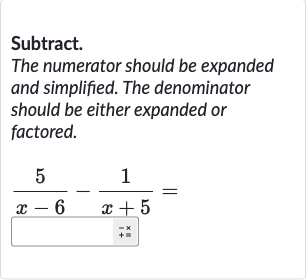Full solution
Q. Subtract.The numerator should be expanded and simplified. The denominator should be either expanded or factored.
- Identify Common Denominator: Identify the common denominator for the two fractions.To subtract the fractions, we need a common denominator. The common denominator will be the product of the two distinct denominators and .Common Denominator:
- Rewrite with Common Denominator: Rewrite each fraction with the common denominator.We need to adjust each fraction so that they both have the common denominator.For the first fraction, , we multiply the numerator and denominator by .For the second fraction, , we multiply the numerator and denominator by .Adjusted Fractions:
- Expand Numerators: Expand the numerators of the adjusted fractions.Now we expand the numerators of both fractions.First Fraction: Second Fraction: Expanded Numerators:
- Combine Numerators: Combine the numerators over the common denominator.Now we combine the expanded numerators over the common denominator.Combined Fraction:
- Simplify Numerator: Simplify the numerator.We need to subtract the second numerator from the first.Simplified Numerator: Simplified Numerator:
- Write Final Expression: Write the final simplified expression.The final simplified expression is the simplified numerator over the common denominator.Final Expression:
More problems from Negative Exponents
QuestionGet tutor help

